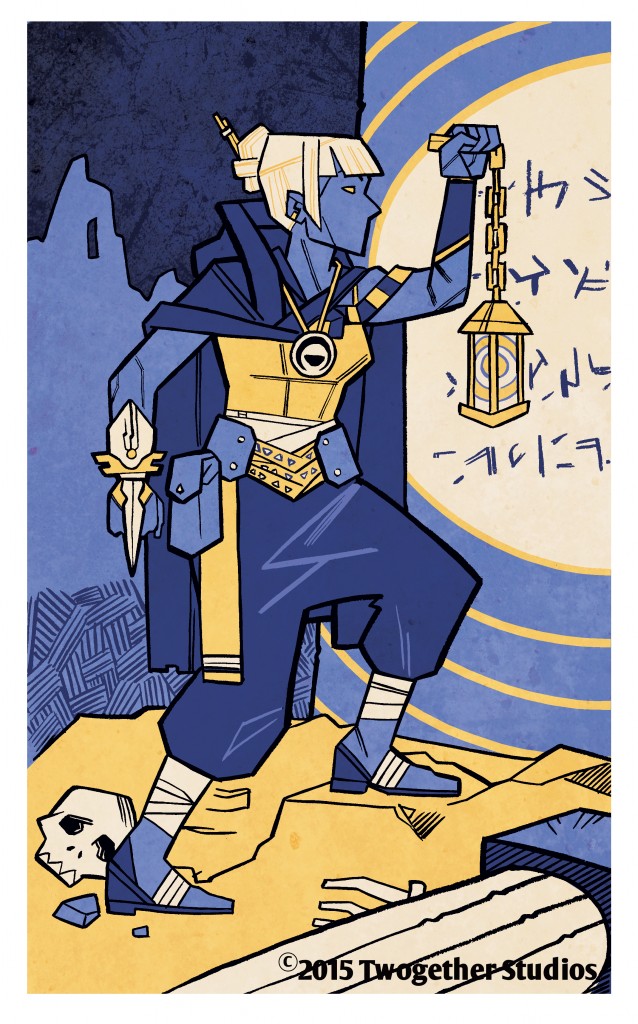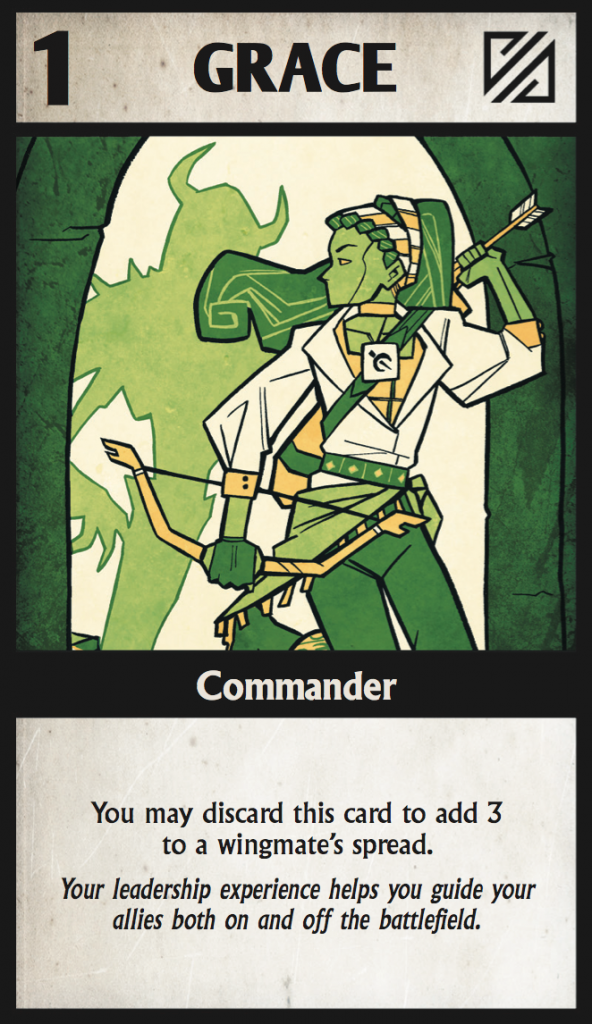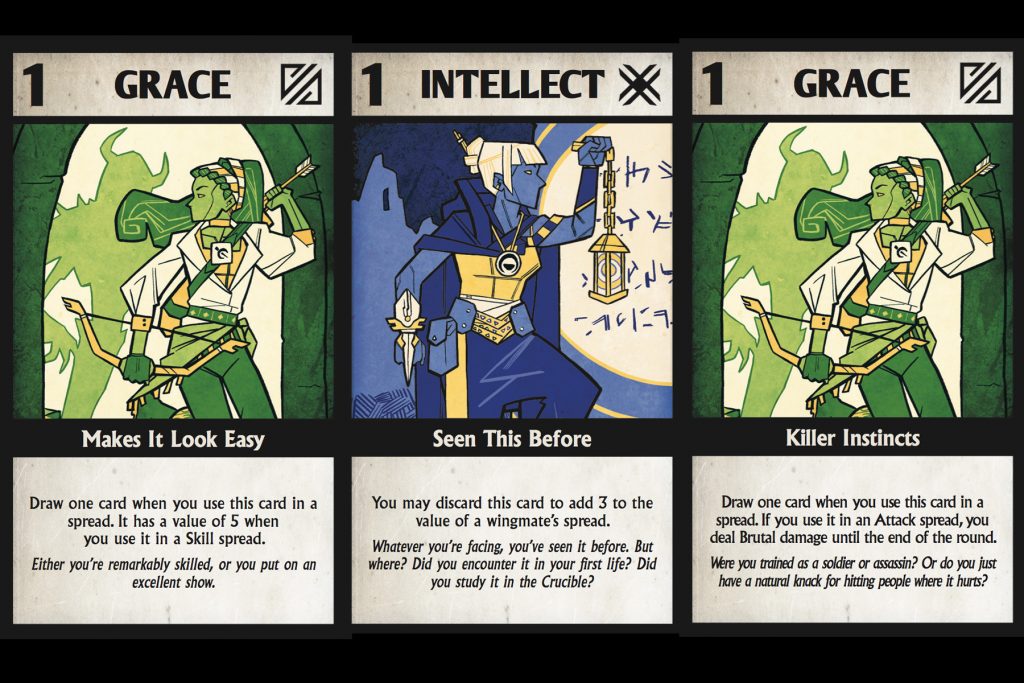
Twogether Studios officially released my new RPG Phoenix: Dawn Command in the beginning of August. Currently, it’s only available through our website, but we intend to get it to retail soon; if your FLGS is interested in carrying it, have them reach out to us at info@twogetherstudios.com. We’ve got lots of plans for ongoing Phoenix support, and I’ll unveil these as soon as the details are ironed out. For now I want to start with some simple Q&As for people who are running or playing Phoenix: Dawn Command. Today I’m going to take a look at the core mechanic.
Phoenix: Dawn Command is a card-based roleplaying game. Each player has a deck of action cards that represent the capabilities and unique traits of their characters. At any given time, a player will have a hand of 5 or 6 cards, reflecting what they are capable of in this moment. There is a random element to this, because you are going through your deck and any given draw might be especially good or bad. But IN THE MOMENT you can look at your hand and know what you’re capable of… so unlike rolling a die, you know when you have a good hand or a bad hand, and the question is what you can accomplish with the resources that are available.
Long ago, Rich Malena posted two videos about Skill Spreads and Combat Spreads. These were done with prototype cards and contain one critical error, but they are still a good basic (and visual) grounding in how the system works and I suggest you take a look at these. The following questions are all dealing with specific aspects of making spreads – but these videos walk you through the basics. So if you aren’t familiar with Phoenix, click on the links and check those videos out. I’ll wait.
Back? OK, let’s get on with the questions.
I’m confused about the basic timing of a spread. Say I play a Trait in the spread that lets me draw a card. Can I then add that card to a spread? Can I exchange this new card for a card that I’ve already played in the spread?
When playing a simple spread, you may just lay down all your cards at once. If you’re making an Attack spread and planning to play Str-3, Str-2, and Gra-4, you can just say “Attack Spread, 9 points!”… because there are no complicated timing issues. However, if there’s any question or timing or choice, you actually want to play your cards one at a time. Here’s how this works.
- When you make a spread, you start by declaring the action you wish to take. The GM approves the action and tells you what type of spread to make and what suits you can use in that spread. This is also a time to figure out the base value of the spread due to any bonuses from Skill Specialties or Lessons. (“I want to lift a heavy rock. Because I have the Athletics specialty, I’ve got a base value of 5.”)
- Declare the first card you are using in the spread. Once you do this, that card is committed to the spread and cannot be swapped out. Now resolve any effects of that card: If it’s a Trait, how are you justifying it? Will the GM increase its value? Does it allow you to draw an extra card? Continue until you have resolved every effect associated with THAT CARD. (Playing the trait Never Gives Up: “We’ve been through a lot, and I’m not going to let this boulder be the thing that keeps us from reaching our goal. I’m never giving up until I lift that rock.” The GM approves this justification and increases the value to 3; it’s appropriate, but not as perfect a match to rock-lifting as, say, Superhuman Strength. In addition, Never Gives Up says “Draw 1 card when you use this in a spread” – so you do that now.)
- Declare the SECOND card you’re using in the spread and go through the same process: does the card have any special effects? Does it need to be justified? (Playing a Strength-4 card… perhaps the one you just drew! Nothing special here.)
- Continue this process until you have played as many cards as you are allowed to play in the spread. Note that any justified Trait doesn’t count towards the limit of cards you can play in a spread, so you can play any number of Traits in a spread, as long as you can justify them.
- Determine the final value of the spread and determine the result.
So: Once you have committed a card to a spread, you cannot remove it or swap it out. However, if a card in the spread lets you draw a new card AND YOU HAVEN’T HIT YOUR CARD LIMIT you can add this new card into the spread. This is a mistake in Rich Malena’s Skill Spread video: he draws a new card and swaps it for a card already in the spread.

If a player is using a Trait to enhance a spread, the only thing that matters is the name of the Trait, not its mechanical effect, right? They only need to explain why “Superhuman Strength” helps in this situation to get its advantage in a narrative way; the fact that I can use the card to stun an opponent doesn’t matter when I’m not using it in a Skill Spread.
This is correct. A Trait has three components.
- Suit and Value (Grace 1)
- Descriptor (Commander)
- Power (You may discard this card to add 3 to a wingmate’s spread)
A player can use the Trait for its base suit and value without providing any justification; they can always just play Commander as a Grace 1 card. They can also use its POWER without any justification; they don’t have to explain how they are adding +3 to a friend’s spread, because that’s just what the card does. However, if they can explain how the descriptor is relevant to what they are doing, they can add it to a spread regardless of suit and without counting against the limit of how many cards you can play… and in a Skill Spread, you as the GM may increase its value based on how appropriate it is and/or the quality of the justification.

I feel some “card names” are quite universal like “Seen This Before”, what if a player uses it to any monster, claiming he’s seen this before and know how to inflict Brutal damage to it? Should I decide as a DM that whether it makes sense or not?
First off, it is always up to you as GM to approve the justification of a Trait and to decide what benefit the Trait provides. And it’s only when used in a Skill Spread that a Trait may get an increased value for a good justification. In a combat spread, the only benefit is that you can add the card in regardless of suit and that it doesn’t count against limit. The POWER of the card may help in combat. So the Trait Killer Instincts does allow the player to get Brutal Damage on an attack, and it’s intentionally pretty easy to justify adding it to an Attack spread, making it a free play. On the other hand, it’s not that broadly useful outside of combat. Meanwhile, Seen This Before is potentially quite universal – but there’s no way a player could use it to get Brutal damage, because it doesn’t do that. When used in a Combat spread, it’s only worth +1 to the spread value. Easy to justify, but not that big of a deal.
Now, in SKILL spreads, justification matters. Based on the strength of the justification, you can decide to increase the value… generally to 3 if the Trait is fairly useful, and to 5 for an extremely good justification. If it’s the absolute perfect Trait for the task – Superhuman Strength when you want to lift a rock – you may decide that they can simply discard the Trait without even making a spread.
So Seen This Before is almost always valid in a Skill Spread… but the strength of the justification still matters. WHERE has the character seen this before? If they’re fighting Chanters and the player says “I dunno, I saw Chanters somewhere” I’d probably let them use it, but only for the +1. If they say “In my first life, I was in a village that got hit by the Chant; I lost my brother in that outbreak” I’d give them at least a +3, assuming that fits with their backstory. If the character says “I got killed by the Chant LAST GAME, remember?” I’d definitely make it a +5, because it’s hard to be closer to the Chant than that. But as the GM, you are always the final judge; the player can’t DEMAND a bonus.
With that said, another critical example here is Makes It Look Easy. This is intentionally an incredibly easy Trait to justify in a spread. Whatever you’re doing, you can always make it look easy. But in Attack or Defense, all it does is give you a +1. And in a Skill Spread, it’s automatically worth +5… which means that the justification doesn’t really matter. Essentially, Makes It Looks Easy is the perfect card for the player who’s NOT good at coming up with justifications, because they don’t have to; the card just hands them the bonus. On the other hand, Seen This Before is one that is easy to justify with a good story and can usually get 3-5 points… and it ALSO has the power of being a strong boost to an ally’s spread. So Seen This Before is a card I encourage storytellers to take, and Makes It Look Easy is one I’d push on a shy player who has trouble justifying things.
If you have more questions about the core mechanic, ask here. You can also get answers to questions on the Phoenix: Dawn Command group on Facebook!

Mea culpa! I meant that to be a little bit of a theory-crafting example, so there wasn’t as much of a distinction between committing cards to the spread and considering what the spread would be in the end. In live play, I certainly wouldn’t allow a committed card to be swapped unless I knew it was a mistake from a new player!
But after watching the video a year and a half later, I wonder what old me was thinking…